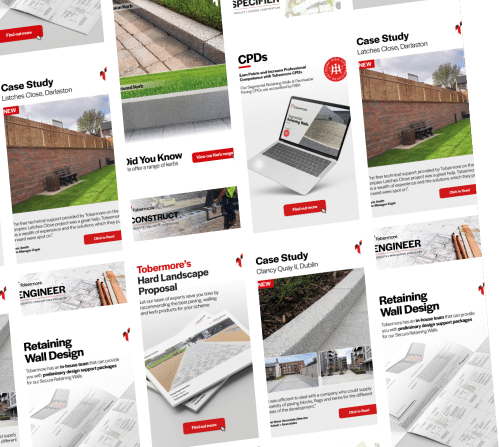-
What is a concrete facing brick?
Concrete bricks are made from a mixture of Ordinary Portland Cement (OPC), high quality aggregates and iron-oxide pigments which are vibrated into moulds and subsequently cured using steam at a high temperature.
-
Do Tobermore supply Facing Bricks?
Yes, we manufacture an innovative range of facing bricks. Find out which type of facing brick would be suitable for your project here.
-
Do Tobermore concrete bricks suffer from efflorescence?
Tobermore use market-leading vapour curing technology in the production process. Products are vapour cured for a minimum 12 hour period which significantly reduces the possibility of efflorescence and speeds up the availability of the product as the vapour curing ensures it hardens much faster than traditional drying-out methods.
-
What is the difference between Tobermore concrete bricks and clay bricks?
Whilst both products are made from different materials and will have different characteristics they can both generally be used in construction for the same purposes.
-
Are concrete facing bricks environmentally friendly?
Concrete Bricks are 100% recyclable
The aggregates used in the manufacturing of our facing bricks are sourced from our own quarry which is only 10 miles away from our factory. This greatly reduces our impact and carbon footprint.
Tobermore concrete bricks are manufactured in the UK and have no adverse environmental impacts associated with imported products such as clay bricks
Concrete Brick have a BRE A+ Rating for brickwork.
-
What is the lifespan of Tobermore bricks?
Whilst this is a difficult question to put an exact figure on and will depend on various circumstances, masonry is one of the most durable components of a building therefore concrete bricks have a potential lifespan in excess of 100 years. Modern concrete manufacturing methods and the use of high quality cement, aggregates and pigments provides concrete bricks with excellent frost resistance and durability. They also benefit from the fact that they increase in strength as they age. Therefore, provided they have been designed and constructed in the correct way and used in the appropriate location they should be suitable for their intended use.
-
What are the main benefits / advantages of building with concrete bricks?
Aggregates – We can guarantee consistency of quality as we use the best aggregates available to ensure we are in complete control of the main raw materials used to produce our facing brick. All of our aggregates are sourced locally within the UK.
Strength – Our facing bricks exceed a minimum crushing strength in excess of 22N/ mm2 and comfortably exceed the performance requirements of the standard. And what’s even better is that Tobermore facing brick will gain strength with age.
Durability – Independent laboratory tests have been carried out and have proven that Lansdowne and Kingston are categorised as frost resistant (F2), offering high durability against the elements.
Voids – We manufacture Lansdowne and Kingston with three perforated voids in each brick. This provides significant benefits for a brick layer as the product bonds to the mortar on both sides and reduces the issue of floating.
Colour – Lansdowne and Kingston are produced in a choice of solid and blended colours which can be used to create complementary and contrasting features alongside our block paving and paving flag products.
Only the best Iron Oxide pigments available in the market are sourced to produce the distinctive colours. These pigments are manufactured to BS EN 12878 and offer excellent colour retention properties as demonstrated through completed projects that have been revisited years after construction and the colours still look as strong and vibrant as ever.
-
My bricks on site are wet. Can I still use them?
For best practice Tobermore facing bricks should only be laid when they are dry therefore it is important to keep them protected prior to use. Wet bricks will be more difficult to lay, may not achieve the correct bond with the mortar and may shrink potentially leading to cracks in the finished brickwork. We recommend that opened packs are protected as should any stacked out bricks on the scaffold. If bricks are wet the packs should be opened and the bricks spaced out to allow air to circulate and allow the bricks to dry out.
-
What is the best way to clean my facing bricks?
It is always important to keep bricks as clean as possible while laying and tooling. Refer to the Tobermore Guide to the use of Concrete Bricks “workmanship” section.
If mortar has been allowed to dry on the surface of the bricks the options you have to clean it off are as follows; Each process should be tested first and should ensure the facing bricks are not damaged – a. Dry brushing b. Wet brushing c. Using a ‘like coloured’ brick to rub the stained brick d. Pressure washing – should only be used as a last resort as it will damage the surface and the mortar joint if not completed correctly (this method cannot be attempted until the area has been allowed to set for a minimum of 7 days)
Acid cleaning should be avoided.
-
What causes micro (hairline) cracks?
The only way to determine the exact cause of cracks is to seek professional advice from a structural engineer / building surveyor before any remedial work is undertaken. Please note failure to detect the underlying cause can lead to repairs not lasting.
All building materials shrink or expand with time. Clay brickwork expands over time and concrete brickwork shrinks as it dries out. The risk of shrinkage cracking is minimised by the introduction of movement joints at no greater than 6 m centres and the avoidance of panels of brickwork where the length: height ratio is greater than 3. The use of brick reinforcement can also reduce cracking. Please refer to ‘Tobermore’s Walling and Masonry Brochure’.
We would advise that you seek expert advice from a structural engineer who can determine why this cracking has occurred and can also provide recommendations on how to prevent this on future builds. Through years of experience we know that micro cracks in brickwork is extremely unlikely to be a product related fault.
-
I have hair line cracks in my brickwork?
Hairline cracks that appear in brickwork can be unsightly and cause concern however it is not usually a major issue unless the cracks are wide and are replicated through to the inner leaf. In cases like this it could indicate a structural issue and will require investigation by a qualified structural engineer.
The majority of hairline cracks in concrete or clay brickwork are caused by moisture or thermal movement. They are usually classed as micro (hairline) cracks which either run through the bricks themselves and/or the bricks and the mortar.
They can occur when the mortar is too strong. If mortar is too strong it prevents sufficient flexibility within the structure.
Cracks can be dealt with as follows:
- Very fine micro cracks: it may be more practical to leave them as any repairs may actually make them more noticeable.
- Slightly wider cracks: Cracked mortar can be raked out and repointed. The cracks in the bricks can be repaired by filling and tinting if necessary.
- If absolutely necessary it is possible to cut out the bricks and mortar and replace. This should be carried out by an experienced bricklayer who has been trained to do this type of replacement. It must be acknowledged that this type of repair may look unsightly at first as it can be difficult to achieve an exact colour match for the mortar. Any differences in colour usually dissipate as the mortar matures.
-
Should I mix Tobermore bricks on site from various packs?
Tobermore produces facing bricks with excellent density and durability. All bricks are manufactured in batches using naturally extracted raw materials including aggregates, pigments and cement etc. To achieve their final appearance Lansdowne bricks undergo a secondary tumbling processes that distresses the edges and corners of the bricks to give the desired aged antique appearance. The process randomly distresses the bricks therefore some blocks may be more distressed than others will, this is completely normal and does not affect the product performance.
Whilst we have several factory procedures in place to help control shade, colour and texture within and between batches we cannot guarantee consistency. This is due to the natural materials used in the manufacturing process. Therefore, slight variations in the finished products is normal between and within batches. These variations actually enhance the character and natural beauty of the products.
To achieve the best possible finish we recommend the following advice is followed to evenly distribute any slight variations in shade, colour and texture over a large area.
When the circumstances allow complete one house / building by using bricks taken from the same batch. This is achieved by checking the batch code label displayed on the packs.
Always, thoroughly mix products from a minimum of three packs.
Where products are supplied in packs with vertical slices always take them “vertically slice by slice” this ensures that colours are distributed evenly.
When the circumstances do not allow the use of products from the same batch then it is extremely important to minimise possible colour banding /shading by always, thoroughly mixing products from a minimum of three packs concurrently with some overlap between deliveries / batches.
Mixing thoroughly from a minimum of three packs is of particular importance when installing single colours such as Charcoal.
We would always recommend that when purchasing products, especially in larger quantities, that they are all ordered at the same time.
Please note that the colour of new products will inevitably vary compared to those that have been installed for a period of time as weathering does take place.
All colour illustrations are as accurate as the printing process will allow. For a more accurate colour match please refer to actual product samples, which can be provided.
Colours and textures illustrated are representations and therefore should not be expected to be an exact match.
-
Can Tobermore bricks be used below the DPC? (damp proof course)
Yes. Tobermore concrete facing bricks are suitable for use above and below DPC, but not as the actual DPC. The relevant standards BS 5628 and PD 6697: 2010 recommend a minimum compressive strength of 22.5N/mm2 for the majority of locations.
-
How should movement be accommodated within the structure?
The provisions of the Eurocode for masonry are written as a principle followed by a series of application rules to achieve the principle. In the case of movement, the principle is:
“The possibility of masonry movement shall be allowed for in the design such that the performance of the masonry in use is not adversely affected by such movement.”
The way of achieving this situation is by the use of movement joints to subdivide large areas of brickwork into smaller panels such that in particular shrinkage of the brickwork does not allow sufficient tension to build up in the wall that it cracks. In particular, long low panels are to be avoided. The maximum spacing of movement joints is a national matter and the National Annex to BS EN 1996-2 recommends a value of 9m for concrete brickwork with the provision that it may be less if the length: height of the sub-panel created exceeds 3:1. In practice, movement joints are often spaced at 6m – 9m as recommended in PD6697. Tobermore recommend a maximum spacing of 6m.
Refer: See Tobermore Walling and Masonry Brochure “Design for Movement”
-
Do I have to make any allowances when building with Tobermore facing bricks?
Constructing using concrete bricks is very similar to using any other masonry products in fact the accuracy of the dimensions of a concrete brick can help with the laying. Bricks should be kept dry and in accordance with BS 8000-3. The height of lifts should not exceed 1.5 metres each day.
See Tobermore’s Walling & Masonry Brochure’s“Good Practice during Construction”
-
What are the differences between using silo batched or pre-mixed mortars compared with site batching and mixing?
For consistency and convenience silo based and pre-mixed factory produced “tub” mixes are usually preferred. Silo based mixes can then be adjusted on site to suit the suction requirements of the bricks.
Site batching and mixing on site is suitable for smaller projects but can cause variations in consistency, especially when coloured mixes are required.
Important: It is essential that the correct strength specification of mortar is used as mortars which are too strong can potentially lead to cracking.
-
What are the preferred mortar joint profiles for Tobermore concrete facing bricks?
The joint profiles in brickwork make up approximately 17% of the overall wall area and different joint profiles can affect both the aesthetics and weathering properties of the wall.
- Raked joints increase the risk of water penetration.
- A concave joint reduces water penetration through the joints. ( Tobermore recommend a concave joint )
Industry guidance for mortar joint specification in masonry.
RAKED JOINT – This joint strongly emphasizes horizontal joints. It is however a very poor weather joint and is not recommended if exposed to weather. This mortar joint incorporates the ledge of the block to create the horizontal lines that are so desirable with this joint. The ledge is however a collector of rain water as it pours down the wall. Eventually the water will find its way around the mortar joint into the interior of the wall and building.
CONCAVE JOINT– This is the most common joint used in masonry construction. The tooling works the mortar tight into the joint to produce a more consistent weather joint. The pattern is emphasized and small irregularities in laying are concealed.
Further guidance can be found here https://nhbc-standards.co.uk/6-superstructure-excluding-roofs/6-1-external-masonry-walls/
-
Can coloured mortars be used with Tobermore facing bricks?
Tobermore concrete facing bricks look fantastic without the requirement for coloured mortars however there are many suppliers of pre-mixed mortars that can supply colour swatches or samples of different coloured mortars if you require it. This is usually a better option than using pigments and making coloured mortars on site as it is difficult to maintain a consistent colour.
See Tobermore’s Walling & Masonry brochure’s selection of mortars.
Products
Back
Constellations
Back
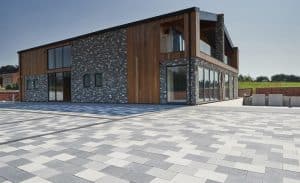 Block Paving
Block Paving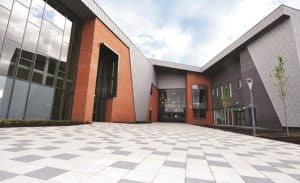 Paving Flags
Paving Flags Permeable Paving
Permeable Paving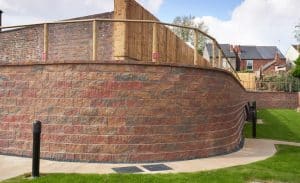 Retaining Walls
Retaining Walls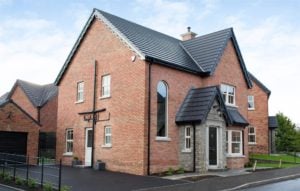 Facing Bricks & Walling
Facing Bricks & Walling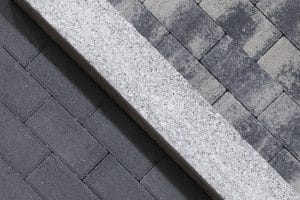 Kerbs & Edging
Kerbs & Edging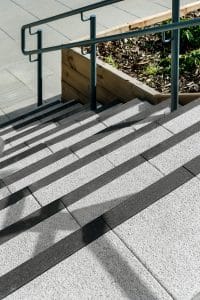 Steps
Steps